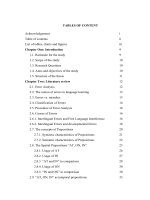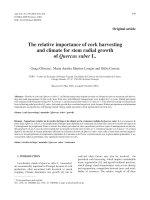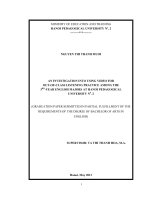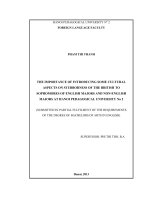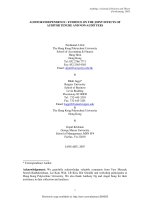The importance of introducing some cultural aspects on stubborness of the british to sophomores of english majors and non english majors at hanoi pedagogical university no 2
Bạn đang xem bản rút gọn của tài liệu. Xem và tải ngay bản đầy đủ của tài liệu tại đây (502.12 KB, 67 trang )
HANOI PEDAGOGICAL UNIVERSITY N0 2
FOREIGN LANGUAGE FACULTY
PHAM THI THANH
THE IMPORTANCE OF INTRODUCING SOME CULTURAL
ASPECTS ON STUBBORNESS OF THE BRITISH TO
SOPHOMORES OF ENGLISH MAJORS AND NON-ENGLISH
MAJORS AT HANOI PEDAGOGICAL UNIVERSITY No 2
(SUBMITTED IN PARTIAL FULFILMENT OF THE REQUIREMENTS
OF THE DEGREE OF BACHELORS OF ARTS IN ENGLISH)
SUPERVISOR: PHI THI THO, B.A
Hanoi, 2013
ACKNOWLEDGEMENT
I owe my deepest gratitude to my supervisor, B.A Phi Thi Tho, without
whose valuable comments and guidance, my research would not have been
accomplished.
My special thanks go to my English friends; Ms. Jasmine Kathleen and Ms.
Jenifer Wells who help me find out the information about their cultures as well as
provide me books and necessary materials.
I wish to thank all the lecturers at Hanoi Pedagogical University Number 2,
especially the lecturers in the Foreign Language Faculty for their dedicated
instructions during years of university work.
I am greatly indebted to my family for their love, support and encouragement.
Finally, I am particularly grateful to my close friends for their enthusiasm
and kindness, to K37 students of Foreign Language Faculty for helping me in
making survey.
i
ABSTRACT
The British culture plays an importance role in teaching and studying
English. Beside the characteristics of Western culture, British culture has typical
aspects which are consider as tokens of “Britishness”. One of these tokens is
stubbornness or conservativeness.
There are quite a lot of books written about British culture, but these books
just discuss this culture in general and do not mention the stubbornness in full.
Therefore, this research work entails introducing the British’s stubbornness
to sophomores of English majors and non-English majors to help them understand
clearly this typical aspect in British culture.
ii
STATEMENT OF AUTHORSHIP
Title: Introducing the British’s stubbornness to sophomores of English
majors and non-English majors at Hanoi Pedagogical University No 2.
(Graduation paper submitted in partial fulfillment of the Degree of Bachelor
of Arts in English)
I certify that no part of the above report has been copied from any other
person’s work without acknowledgements and that the report is originally written
by me under the instructions of my supervisor.
Date submitted: May 2013
Student
Supervisor
Pham Thi Thanh
Phi Thi Tho
iii
LIST OF ABBREVIATIONS
HPUN2
: Hanoi Pedagogical University Number II
SI
: International System of Units
USSR
: Union of Soviet Socialist Republics
TNT
: Trinitrotoluene
EU
: European Union
UK
: United Kingdom
BST
: British Summer Time
GMT
: Greenwich Mean Time
DST
: Daily Savings Time
RoSPA
: Royal Society for the Prevention of Accidents
SDST
: Single Double Summer Time
EC
: European Community
ELT
: English Language Teaching
iv
LIST OF FIGURES AND TABLES
Figure 1: The result of the students’ attitude towards the British’s
stubbornness......................................................................................................... 38
Table 1: Holidays and events..................................................................... 53
Table 2: List of country driving on the left side ......................................... 54
Table 3: Cities and countries using double-deckers ................................... 55
Table 4: SI base units ................................................................................ 56
Table 5: Units of measurement in Britain .................................................. 57
Table 6: List of countries changing the clocks ........................................... 58
Table 7: Time when British change their clocks ........................................ 58
v
TABLE OF CONTENTS
ACKNOWLEDGEMENT .................................................................................... i
ABSTRACT .......................................................................................................... ii
STATEMENT OF AUTHORSHIP .................................................................... iii
LIST OF ABBREVIATIONS ............................................................................. iv
LIST OF FIGURES AND TABLES.................................................................... v
TABLE OF CONTENTS .................................................................................... vi
PART ONE
INTRODUCTION
I.
Rationale ....................................................................................................... 1
II. Research presupposition .............................................................................. 2
III. Research objectives ...................................................................................... 2
IV. Research scope.............................................................................................. 2
V.
Research tasks .............................................................................................. 3
VI. Research methods......................................................................................... 3
VII. Research significance ................................................................................... 3
VIII. Research design ........................................................................................... 4
PART TWO
DEVELOPMENT
CHAPTER ONE: LITERATURE REVIEW
I. An overview of culture and British culture..................................................... 5
I.1. Culture ............................................................................................................. 5
I.2. British culture .................................................................................................. 7
II. The British’s conservativeness (stubbornness) ............................................ 10
II.1.What is conservativeness or stubbornness? .................................................... 11
II.2.The British stay stubbornly different.............................................................. 12
II.2.1. Left-hand side driving ................................................................................ 12
II.2.1.1. History .................................................................................................... 12
vi
II.2.1.2. Left-hand side driving in Britain ............................................................. 16
II.2.2. Double-decker bus ..................................................................................... 17
II.2.2.1. History .................................................................................................... 17
II.2.2.2. Description ............................................................................................. 18
II.2.2.3. Double-decker buses in United Kingdom and the differences ................. 19
II.2.3. System of measurement ............................................................................. 21
II.2.3.1.What is system of measurement? ............................................................. 21
II.2.3.2. Classification .......................................................................................... 22
II.2.3.2.1.Imperial and US Customary .................................................................. 22
II.2.3.2.2. Metric system....................................................................................... 23
II.2.3.2.3. SI System ............................................................................................. 25
II.2.3.2.4.Other types of measurement system ...................................................... 25
II.2.3.3. System of measurement in Britain and the conservativeness ................... 26
II.2.4. Clock changing in Britain .......................................................................... 28
II.2.4.1 Origin of changing the clocks .................................................................. 29
II.2.4.2.The British Summer Time (BST) and the stubbornness ........................... 30
CHAPTER TWO: THE METHODOLOGY
II.1. Purpose of the survey.................................................................................... 32
II.2. Population of the survey ............................................................................... 32
II.3. Type of the survey ........................................................................................ 33
II.4. Construction of the survey ............................................................................ 33
II.5. Preparation of the survey .............................................................................. 33
II.5.1. Test items .................................................................................................. 33
II.5.2. Arrangement of the test items .................................................................... 34
II.6. Administration of the try-out ........................................................................ 34
II.6.1. Preparation of the try-out ........................................................................... 34
II.6.2. Try-out ....................................................................................................... 34
II.7. Method of data analysis ................................................................................ 34
vii
CHAPTER THREE: THE RESULTS OF THE SURVEY
III.1. The results of the survey........................................................................... 36
III.1.1. The results of the students’ attitude towards the importance of learning
British culture in learning English. ....................................................................... 36
III.1.2. The results of the students’ attitude towards the British’s stubbornness .... 37
III.2. Suggested solutions ................................................................................... 39
III.2.1. Suggested solutions for teacher................................................................. 39
III.2.2. Suggested solutions for student ................................................................ 41
PART THREE
CONCLUSION
CONCLUSION................................................................................................... 43
REFERENCES ................................................................................................... 45
APPENDICES .................................................................................................... 47
SURVEY QUESTIONNAIRE ............................................................................. 47
viii
PART ONE
INTRODUCTION
I. RATIONALE
Nowadays, it cannot be denied that English is the most commonly used
language among foreign language speakers. Throughout the world, when people
with different languages come together they commonly use English to
communicate. In addition, English is commonly spoken throughout much of the
world due to Great Britain’s expansion during the colonial age. People in
Australia, New Zealand, Canada, and parts of Africa, India, and many smaller
island nations speak English. English is the commonly adopted second language in
Germany, Norway, Sweden, Denmark and the Netherlands.
As we know, language teaching and culture teaching have a dual nature. In
order to conduct language teaching well, one must take up the teaching of culture
and the teaching of language at the same time. When we learn a foreign language,
we do more than learn a linguistic system. We acquire some degree of familiarity
with the foreign cultural system.
It is now broadly accepted that learning a foreign language is not simply
mastering the grammar, the vocabulary, but appropriately focusing more on
learning a means of communication. Communication in real situations is never out
of context, and because culture is part of most contexts, communication is rarely
culture-free. It means that if we use the same word in different culture, we would
get different psychological response. For example, when reading the sentence "It's
morally hard to turn her away as it is a lost dog", most students put "a lost dog"
into literal meaning which totally shows our feeling of disgust and dislike for the
dog. But it is not the case in western countries. In the western culture, dogs are
regarded as faithful friends and companions. So the actual meaning of "the lost
dog" here means something precious, valuable and adorable is lost. It's obvious
that neglecting the cultural difference results in the misunderstanding.
In Vietnam, learning and teaching English as a second language is paid more
and more attention and furthermore, English becomes more and more popular. To
1
study English effectively, as mentioned above, studying about culture of countries
speaking English is very crucial. We cannot mention culture of these countries
without mentioning the American and British culture. However, British culture has
some different salient features.
With the aim of helping learners of English, especially sophomores of
English majors and non-English majors at HPU2 to have knowledge about the
British’s stubbornness as well as “Britishness”, this thesis is focused on finding out
how British stay stubbornly different and giving the reasons and the origins of
these differences.
II. RESEARCH PRESUPPOSITION
Based on the knowledge on British culture, some questions are raised in
about this topic:
1. Why is it said that the British stay stubbornly different?
2. How does the British stay stubbornly different?
3. What are the origins of the stubbornness?
4. What are some effective ways that help the students and ELT teachers
study British culture well?
Based on these questions, I am eager to study about the British’s
stubbornness and the origins as well as how their stubbornness is.
III. RESEARCH OBJECTIVES
The study is aimed at achieving the following goals:
1. To find out more information about British culture and British people as well
2. To figure out how British stay stubbornly different
3. To explain the reason as well as the origin of those stubborn differences.
IV. RESEARCH SCOPE
This thesis is focused on studying the conservativeness as well as
stubbornness of British. Because seniors of English major have to study about
American-British Culture and in the textbook, there is only a short article written
on “British stay stubbornly different”, this thesis intended to serve the learners of
English, especially sophomores, basic knowledge on some different aspect of
2
British culture and orient students to studying American- British Culture
efficiently.
V.
RESEARCH TASKS
The research work involves fulfilling a number of tasks:
1. To study how British stay stubbornly different.
2. To study more about the origin as well as the reason of the differences in
British style.
VI. RESEARCH METHODS
With the aim of finding out how British stay stubbornly different, the
research method applied in this thesis is searching and material analysis with the
assistance of the survey.
VII. RESEARCH SIGNIFICANCE
Culture is always an extensive phenomenon. It takes a long process in its
own right to understand the culture of a country. In addition, understanding the
culture of a foreign country is not easy for learners who study English as a second
language.
This is the first time the research that surveys how student understand about
British culture has been done at HPUN2. Especially, the survey is carried out with
sophomores of 40 non-English majors and 40 English-majors (K37 students).
Therefore, this thesis gives the theoretical background about how the British stay
stubbornly different, states the origins and the reasons of their differences for
learners of English in general and the sophomores of English major who is oriented
towards studying on British Culture in the third year in particularly. Hence, both
teachers and learners can gain benefits from this thesis. They are given a
comprehensive view on the typical in aspects of British culture. To the teachers,
this thesis provides detailed information about the British’s conservativeness and
teachers of English can help students when they question it. In another hand,
students can benefit from this thesis the comprehensive view on the British culture
and their stubbornness as well. Thence they have background knowledge and study
better when officially study in the third year.
3
VIII. RESEARCH DESIGN
The thesis has 3 main parts: the introduction, the development and the
conclusion.
The part “Development” consists of three chapters. Chapter one is named
“Literature review”, which has 2 sections known as “Overview of Culture, British
Culture and British People”, “The British’s conservativeness”. The first section
mentions the culture and British culture in the general with different aspects. The
second discusses how the British conservative as well as the origin of this
stubbornness.
Part II and Part III are named “The Methodology” and “Conclusion” in
succession. In two these part, the surveys are shown as well as analyzed, then the
discussion and suggested solutions are indicated.
4
PART TWO
DEVELOPMENT
CHAPTER I: LITERATURE REVIEW
I. AN OVERVIEW OF CULTURE AND BRITISH CULTURE
I.1. Culture
Culture is human’s product and the impact of humanity’s evolvement.
Culture makes man unique and different from other kinds in the world of living
being. There are many definitions describing what culture is. The first meaning of
“culture” in Chinese is tattoo through which people can tell them apart others,
show the incorporation into the deities or the mysterious force of nature, and take
up supernatural power. According to the language of the Western, (“culture” in
English and French, “kultur” in German), “culture” is a word derived from
different forms of a Latin verb “colere” which are colo, colui, cultus. These words
have two meanings: conservation, care and creation in farming and worship. In the
daily life, culture is known as literature, art like poetry, fine arts, theatre, and
cinema. In other hand, culture is a lifestyle including cuisine, clothing, behavior,
belief. In anthropology and sociology, the definition of culture is mentioned in an
extensive meaning. Culture includes everything which is a part in the human life.
Culture is things related not only spirit but matter.
Many authors gave the different points of view on culture. CARLA, Centre
for Advanced Research on Language Acquisition, defined culture that “For the
purposes of the Intercultural Studies Project, culture is defined as the shared
patterns of behaviors and interactions, cognitive constructs, and affective
understanding that are learned through a process of socialization. These shared
patterns identify the members of a culture group while also distinguishing those of
another group.”
In another hand, Matthew Arnold said that culture is a study of perfection
which insists on becoming something rather than in having something, in an
inward condition of the mind and spirit, not in an outward set of circumstances.
5
In Multicultural Education by Banks, J.A., Banks, & McGee, C. A. (1989),
it is said that most social scientists today view culture as consisting primarily of the
symbolic, ideational, and intangible aspects of human societies. The essence of a
culture is not its artifacts, tools, or other tangible cultural elements but how the
members of the group interpret, use, and perceive them. It is the values, symbols,
interpretations, and perspectives that distinguish one people from another in
modernized societies; it is not material objects and other tangible aspects of human
societies. People within a culture usually interpret the meaning of symbols,
artifacts, and behaviors in the same or in similar ways."
Damen (1987) in Culture Learning: The Fifth Dimension on the Language
Classroom gave his viewpoint that culture learned and shared human patterns or
models for living; day- to-day living patterns. These patterns and models pervade
all aspects of human social interaction. Culture is mankind's primary adaptive
mechanism.
Moreover, in a book named Culture: A critical review of concepts and
definitions Kroeber, A.L., &Kluckhohn, C. (1952) mentioned that culture consists
of patterns, explicit and implicit, of and for behavior acquired and transmitted by
symbols, constituting the distinctive achievements of human groups, including
their embodiments in artifacts; the essential core of culture consists of traditional
(i.e. historically derived and selected) ideas and especially their attached values;
culture systems may, on the one hand, be considered as products of action, and on
the other as conditioning elements of further action.
However, to sum up, Useem(1963) in Human Organizations claimed that
culture has been defined in a number of ways, but most simply, as the learned and
shared behavior of a community of interacting human beings.
Each country has a different culture. One's culture is an amalgamation of so
many different elements like history, art, cuisine, language and many other
tangible and non-tangible aspects. Taking off the shoes before getting in a house or
bowing when greeting in Japan, remembering to try “kimchi” when going to
Korea, Netherland famous for tulips, “phở” Hanoi in Vietnam are some of so many
6
examples showing the characteristics in the culture as well as life in different
countries. Studying a single culture in-depth requires immense effort and time to
fathom the core values and fundamentals.
I.2. British culture
Being one of countries speaking English, Britain (or Great Britain) is the
largest island in the UK. The United Kingdom is made of the countries of England,
Scotland, Wales and Northern Ireland. Its full name is the United Kingdom of
Great Britain and Northern Ireland. Great Britain, on the other hand, comprises
only England, Scotland and Wales. Britain ranks 20thin the world in terms of
population size. The population of the UK is more than 60 million. The total
population of England, Wales, Scotland, and Northern Ireland is estimated in
succession at 50 million, 2.95 million, 5.1 million and 1.7 million people. England
has the highest population density and Scotland has the lowest. Many parts of
London, such as Islington or Highgate, were once villages (small towns). Today,
London is a growing city with a population of more than seven million. People
have come from all parts of the world to live here. They have brought with them
different ways of living and colorful festivals. London is a multicultural city, as it
has been since the Roman times. This city has the largest non-white population of
any European city and over 250 languages are spoken there. Therefore not all
British people are White or Christians.
To live in Britain means that you could enjoy a very good standard of living
with life expectancy for men being nearly 76 years and 81 years for women. The
rate of unemployment is low (4.8%). On the negative side, 17 % of the population
is living below the poverty line. The UK covers an area of 244,820 sq km with the
famous tourist attraction and so many typical things in their culture as well as
political, climate and life of people here.
Life in Britain is an interesting amalgamation of international cultures and
modern mentality cemented together based on the spirit of powerful national
character and tradition.
7
People in Britain, a multi-cultural country, derived from different races,
religions and cultures. Christianity is a religion having the most prayers in Britain.
In most of town and city of Britain, there are movie theaters showing the
newest movie in the world. Britain is also famous for lots of country heritages such
as Edinburgh Palace and well-known museum of the Beatles in Liverpool, the
Royal Opera House and The National Theatre, London’s tube, Buckingham Palace,
Big Ben, Downing Street, Trafalgar Square, Westminster Abbey ( one of the
famous churches in London which is more than nine hundred years old), British
Museum, Madame Tussaud’s Museum ( the most famous tourist attraction), the
main shopping street Oxford Street and try travelling by double-decker bus, a
symbol of London. Britain has so many museums but the biggest museum is
British museum located in London with many collections of more than seven
millions objects. The collection of this museum is one of the biggest and the most
sufficient collections in the world which derived from every continents and
showing human’s life from the dawn of human kind.
The British Library in London is national library and this is one of the
biggest libraries of research in the world containing more than 150 million objects
and 25 million books in every languages and formations.
Britain is more famous for pop music than it is for classical composers or
jazz musicians. Names such as The Beatles, the Rolling Stones, Led Zeppelin, Pink
Floyd, Elton John, George Michael and The Spice Girls are known worldwide.
Nowadays, there are every kinds of music listened in Britain, such as pop, rock,
electro, hip-hop, classic, country, jazz, opera with many famous singers and music
bands like Nightwish, Beyonce, Pink, Britney, Justin Timberlake, and so on.
A lot of monuments and statues were built in the prehistoric time; among
them are the most well-known monuments like Stonehenge, Devil’s Arrows,
Rudston Monolith and Castlerigg. Classical architecture including the systems and
building methods of Greece is also popular with imperial palaces, hoop-stages,
Triumphal Arch, villas, Roman castle, and so on.
8
Many festivals and holidays in Britain are centuries old. Every towns,
villages and hamlets in Britain has its own traditions, some involving months of
careful planning and preparations of costumes and choreography, others requiring
simply a worrying desire to make a complete and utter fool. The main holidays of
British are Xmas, Easter and New Year. In addition, there is a holiday of Bank
named Bank Holiday when all the banks and many workplaces closes. The
holidays of British are different in each year and the number of days off is also
different. For example, in terms of Bank Holiday, people have 8 days off in Wales,
9 days in Scotland and 10 days in North Ireland. During a year, there are lots of
holidays and events which are held in different times of months. ( Table 1).
Britain is full of culture and traditions which have been around for hundreds
of years. British customs and traditions are famous all over the world. When
people think of Britain they often think of people drinking tea, eating fish and
chips and wearing bowler hats and pubs, beer, cricket, royal family, and also
Shakespeare. Some socialists and researchers have been studying about British
culture as well as updating the changes of country and people in Britain. Annne
Collins (2001) in “British life” gives us a comprehensive view on British life and
ordinary British people. He also mentions some changes in British life nowadays.
In “Customs and Traditions in Britain”, Stephen Rabley (1986) discusses
Britain with full of customs and traditions. A lot of them have very long histories.
Some are strange and some are funny, but they are all interesting and are all part of
the British way of life.
David McDowall in “ Britain in close-up” , section 8 “ Culture and style:
national self-expression” states how the aspects of British society express
themselves and the overall view of culture and style of British such as dress code,
art, sport, and so on.
In “Rules, Britannia”,Toni Summer Hargis provides a comprehensive
knowledge on people and life in Britain. He also covers a wide variety of subjects
including driving, shopping, dining out, managing with small children and taking a
vacation.
9
Christopher S. Chapman (2005) in “Controlling strategy, management,
accounting and performance measurement” mentions the system of measurement
in Britain and also how to account, manage and perform measurement as well. He
express understandably and scientifically.
In addition, David Christopher (1999) in “British culture, an introduction”
explores highly varied nature of culture and the arts in Britain including the social
cultural context, language and culture, theatre, cinema, fashion, architecture and
interiors.
In “Britain: The country and its people, an introduction for learners of
English”, James O’driscoll also give the readers the overall about the country, its
history as well as its geography and the life of British.
In summary, culture in general and British culture in particular is very
complicated and extensive. There are many researchers mentions British culture in
many different aspects. However, the research about the British stubborn style is
rare and there are not many researches collected all of aspects related to this issue.
Therefore, it is necessary to have a study about how British stay stubbornly
different and the origins of their difference.
II. The British’ conservativeness (stubbornness).
The British are said to be reserved in manners, dress and speech. They are
famous for their politeness, self-discipline and especially for their sense of humor.
British people have a strong sense of humor which sometimes can be hard for
foreigners to understand. However, it is also said that the British stay stubbornly
different. They are conservative with many characteristics and typical things called
as British values.
The British values or the “Britishness” as many may call it revolve around
the British people as well as British life and how they interact with each other in
the society. Many people may say that Britain has basic and mutual values due to
British stereotypes. Britain has grown over the years, and this country has the
ethnic and cultural diversity. The British have tried to hold on to values as far as
national history. They struggle to keep their values. Having faced obstacles
10
regarding conflicts connected to colony dispenses, Britain has had strong values
that we still recognize today, for example, a British tea party, double-deckers, or
currency. Every person comes from a specific country and culture. And every
country characterizes some specific values.
The British can be particularly and stubbornly conservative about anything
which is perceived as a token of “Britishness”. In these matters, their conservatism
can combine with their individualism. They are rather proud of being different.
II.1.What is conservativeness or stubbornness?
According to the Oxford Advance Learner’s Dictionary, the word
“conservative” has some following meaning. The first meaning is “opposed to
great or sudden social change, showing that you prefer traditional styles and
values, for example,
The conservative views of his parents make him crazy.
The second meaning is connected with the British Conservative Party, like
Conservative members or supporters. The third meaning is related to estimate
meaning lower than what is probably the real amount or number. For example,
At a conservative estimate, he’ll be earning $50.000.
In the website Wattpad.com, being “conservative” means that people always
favor traditional views and values and tend to oppose changes. In other words,
people are disposed to preserve existing conditions, institutions, etc., to restore
traditional ones, and to limit changes.
For example, in some countries in Asia, people often have social
conservatism. The marriage between a man and a woman must be accepted by
their parents. In addition, having sex before marriage is very bad and the girl who
is pregnant before the wedding is considered depraved.
Moreover, in some
countries, if the bride is fat, it is no good and she does not look good. However, in
Montana, before the wedding, the bride try to eat as much as possible to have a big
body and people believe that fat brides are gorgeous and the bridegrooms are proud
of their woman. A girl cannot even get marriage if she is not fat.
11
Another example is Indian. They do not use chopsticks, forks or spoons to
take the food, instead of those, they use their hands. People have to wash their
hands before eating if they do not want to be infected parasitic worms.
On the other hand, many countries promote public morality and traditional
family values; support the prohibition drugs, prostitution, premarital sex and nonmarital sex and so on.
Each country has its own national proud and the British is not an exception.
The British is considered so conservative and their conservatism is shown in lots of
different traits.
II.2.The British stay stubbornly different
II.2.1. Left-hand side driving
II.2.1.1. History
Why do people in Britain and some of their former colonies drive on the left
side of the road? Is it just a case of clinging stubbornly to an outdated tradition,
such as the confusing English system of measures? This is a good question when
anyone think of British and left-handed side driving in Britain.
About a quarter of the world drives on the left, and these countries that do
are mostly old British colonies. This strange quirk perplexes the rest of the world.
In terms of left-hand traffic, there are some different points. They are:
All traffic is generally required to keep left unless overtaking.
Oncoming traffic is seen coming from the right.
Right-turning traffic must cross oncoming traffic.
Most traffic signs facing motorists are on the left side of the road.
Traffic on roundabouts (traffic circles or rotaries) goes clockwise.
Pedestrians crossing a two-way road look first for traffic from their right.
The lane designated for normal driving and turning left is on the left.
Most dual carriageway (divided highway) exits are on the left.
Other vehicles are overtaken (passed) on the right, though in some
circumstances overtaking on the left is permitted.
Most vehicles have the driving seat on the right.
12
A left turn at a red light may be allowed after stopping.
On roads without a footpath pedestrians may be advised to walk on the
right.
For the countries that drive on the right-hand side, those things are so queer
and opposite and they caused confused. However the origin as well as the history
of left-hand side driving is reasonable and straightforward.
During the Middle Ages, almost everybody travelled on the left side of the
road because that was the best choice for feudal, violent societies of mostly righthanded people. The roads weren’t always very safe for travelers and meeting
people coming the other way on the road was something best done defensively.
People never knew who they would meet on the road in those days. On a horse, if
people are right handed and they meet some unsavory company on the road, they
could draw their weapon, typically attached to their left side, with the right hand
and bring it to bear quickly against the person who is going the opposite way of
them on their right side. That is also reason why swordsmen preferred to keep to
the left. Therefore, they have their right arm nearer to an opponent and their
scabbard further from him. In another hand, travelling on the left-handed side
reduced the chance of the scabbard worn on the left hitting other people. Moreover,
if people happened to meet a friend on the road, they could more easily offer the
right hand in greeting without needing to reach across the body when on
horseback. People on horseback then also typically ruled the road, so everybody
else followed suit.
In addition, jousting knights with their lances under their right arm naturally
passed on each other's right, and if they passed a stranger on the road, they walked
on the left to ensure that their protective sword arm was between themselves and
that stranger.
Another reason is that the right-handed people find it easier to mount a horse
from the left side of the horse. It is safer to mount and dismount towards the side of
the road, rather than in the middle of traffic, so if people mount on the left, they
should ride the horse on the left side of the road. There are 75 countries whose
13
inhabitants drive on the left-hand side of the road and most of these countries were
British colonies or at some time part of British Empire. ( Table 2)
In the past, there were some countries that drove on the left firstly, but then
they changed.
In the early18th century, teamsters in the United State drove large wagons
with a team of horses to haul farm products. However, in many of those old, large
American wagons, they did not include a seat on the wagon for the driver. When
the driver was right handed, the driver would typically sit on the rear left most
horse. This allowed them to easily drive a whole team of horses with a lash in their
right hand.
Besides, when driver sat on the left and everybody passed on the left, so
driver could look down and make sure that any part of their team or wagon didn’t
collide with oncoming traffic. This was much easier to do when using a keep-right
rule of the road and this would also gave the drivers much greater visibility of
oncoming traffic when sitting on the left of the wagon. Gradually, this system
spread so that by the late 18th century, the first laws in the United States were
passed, starting in 1792 in Pennsylvania, where the rule of the road was now
officially a keep-right rule. This quickly spread throughout the United States and
Canada.
After that, driving on the right side spread through Europe and started with
France.
The Revolutionary France overturned this practice as part of its sweeping
social rethink. A change was carried out all over continental Europe by Napoleon.
He enforced right rule traffic in all countries occupied by his armies. It is said that
because Napoleon was left handed person, his armies had to march on the right so
he could keep his sword arm between him and any opponent. Even after Napoleon
was defeated, the custom endured and most of the countries he had conquered
chose to continue with the keep-right system.
14
From then on, any part of the world which was at some time part of the
British Empire had left-hand traffic and any part colonized by the French had righthand traffic.
In the early years of English colonization of North America, English driving
customs were followed and the colonies drove on the left. However, after gaining
independence from England, they wanted to throw off its colonial past as quick as
possible and gradually shifted to driving on the right. In the other hand, the
influence of other European countries’ nationals should be counted.
From then on many countries changed out of necessity such as Dutch,
Canada, Indonesia, Suriname, Portugal, Italy, Spain, Austria (half the country
drove on the left and half on the right, this was the area affected by Napoleon’s
conquests in 1805), Czechoslovakia, Hungary, Gibraltar, China, Korea, Nigeria
Meanwhile, the power of the right kept growing steadily. American cars were
designed with driving on the right by locating the drivers' controls on the vehicle's
left side. With the mass production of reliable and economical cars in the United
States, initial exports used the same design, and out of necessity, many countries
changed their rule of the road.
The last European country to convert to driving on the right was Sweden in
1967.After the Second World War, Sweden, the odd one out in mainland Europe,
was under pressure to change sides in order to conform to the rest of the continent.
The problem was that all their neighbors already drove on the right side and
everyone was getting used to right-hand driving. They got tired of having to make
different versions for domestic use and export. Therefore, people paid more
attention and took more care. Finally, in 1963, the Swedish parliament passed a
law on the conversion to right-hand driving. After Sweden's changeover, Iceland
changed the following year, in 1968 and then, Nigeria swapped sides in 1972 and
Ghana did the same thing in 1974.
The trend among nations over the years has been toward driving on the right.
However, Britain has done its best to stave off the global homogenization. With the
expansion of travel and road building in the 1800s, traffic regulations were made in
15
every country. Left-hand driving was made mandatory in Britain in 1835.
Countries which were part of the British Empire followed suit. This is reason why
today, India, Indonesia, Australasia and the former British colonies in Africa go
left. In terms of Japan, the English minister going to Japan achieved the coup of
his career in 1859 when he persuaded his hosts to make keep-left the law in the
future home of Toyota and Mitsubishi. This led to left-hand driving in Samoa. It
had been driving on the right since it had become a German colony in the early
20th century, although it was administered by New Zealand after the First World
War and gained independence in 1962. Prime Minister of this island country
wanted to swap sides to make it easier to import cheap cars from left-hand driving
Japan, Australia and New Zealand.
II.2.1.2. Left-hand side driving in Britain
In How England made the English: From why we drive on the left to why
we don’t talk to our neighbors, Harry Mount mentioned that Britain never adopted
right-hand driving primarily because massive wagons, as became common in the
United States, didn’t work well on narrow streets which were common in London
and other cities of Britain. In another hand, Britain was also never conquered by
Napoleon or later Germany. Thus, they kept the classical keep-left rule of the road
that had endured for hundreds of years before. Lastly, by 1756, this was actually
made an official law in Britain. When the British Empire expanded, this keeps left
rule as a law and spreads throughout the world. However, this hasn’t endured in
most of the former British ruled countries, thanks to the growing popularity of the
keep-right system.
Actually, EC would like Britain to fall into line with the rest of Europe and
in the 1960s, Great Britain also considered changing. However, this is no longer
possible. The country’s conservative powers did everything they could to oppose.
In the other hand, the fact that it would cost billions of pounds to change
everything wasn’t much of an incentive. Eventually, Britain dropped the idea. The
British continued to drive on the left, not realizing that the tide of history was
running against them. As mentioned above, Britain has done its best to stave off
16


